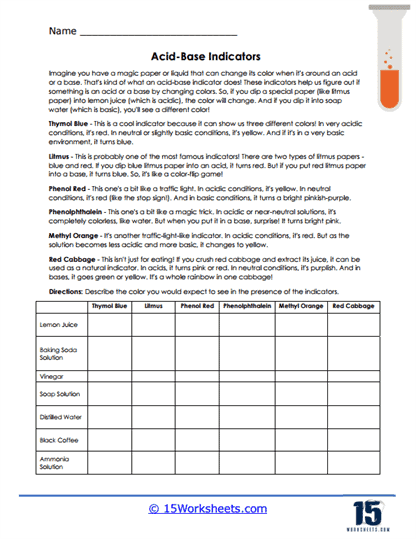Acid-Base Indicators

Worksheet Description
Imagine you have a magic paper or liquid that can change its color when it’s around an acid or a base. That’s kind of what an acid-base indicator does! These indicators help us figure out if something is an acid or a base by changing colors. So, if you dip a special paper (like litmus paper) into lemon juice (which is acidic), the color will change. And if you dip it into soap water (which is basic), you’ll see a different color!
Thymol Blue – This is a cool indicator because it can show us three different colors! In very acidic conditions, it’s red. In neutral or slightly basic conditions, it’s yellow. And if it’s in a very basic environment, it turns blue.
Litmus – This is probably one of the most famous indicators! There are two types of litmus papers – blue and red. If you dip blue litmus paper into an acid, it turns red. But if you put red litmus paper into a base, it turns blue. So, it’s like a color-flip game!
Phenol Red – This one’s a bit like a traffic light. In acidic conditions, it’s yellow. In neutral conditions, it’s red (like the stop sign!). And in basic conditions, it turns a bright pinkish-purple.
Phenolphthalein – This one’s a bit like a magic trick. In acidic or near-neutral solutions, it’s completely colorless, like water. But when you put it in a base, surprise! It turns bright pink.
Methyl Orange – It’s another traffic-light-like indicator. In acidic conditions, it’s red. But as the solution becomes less acidic and more basic, it changes to yellow.
Red Cabbage – This isn’t just for eating! If you crush red cabbage and extract its juice, it can be used as a natural indicator. In acids, it turns pink or red. In neutral conditions, it’s purplish. And in bases, it goes green or yellow. It’s a whole rainbow in one cabbage!
